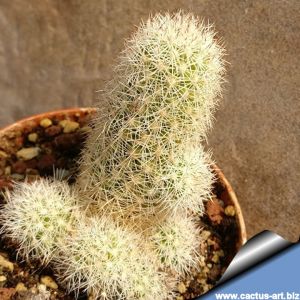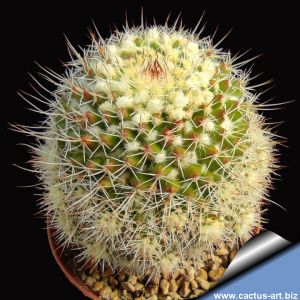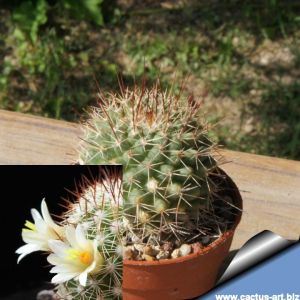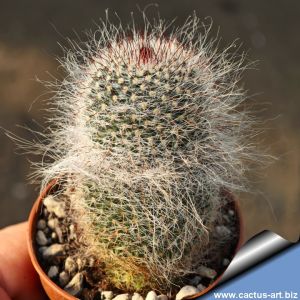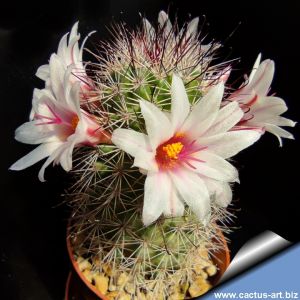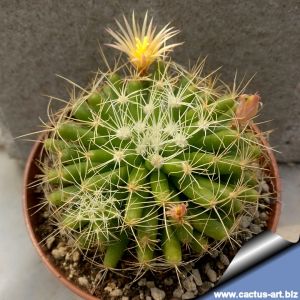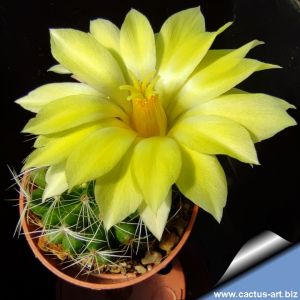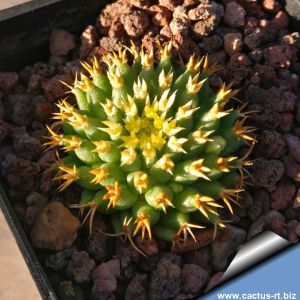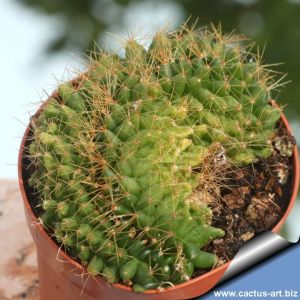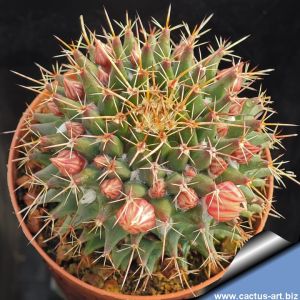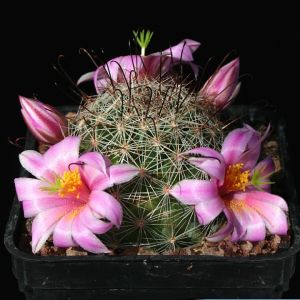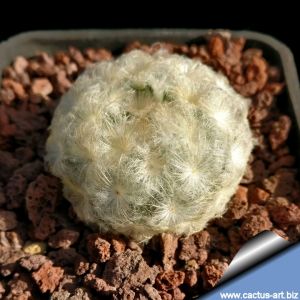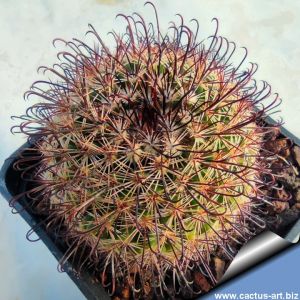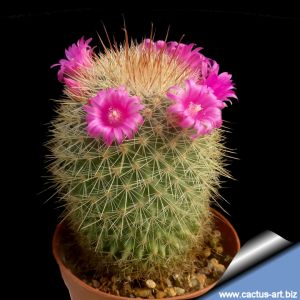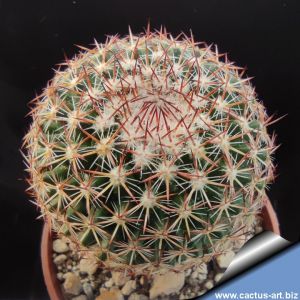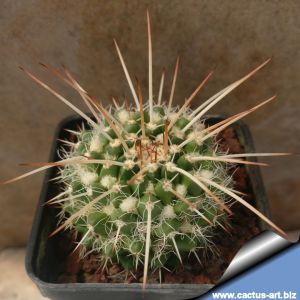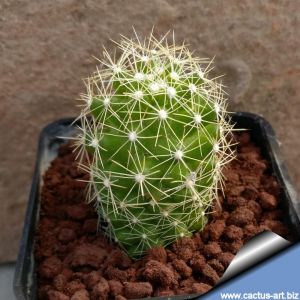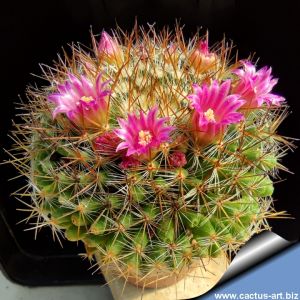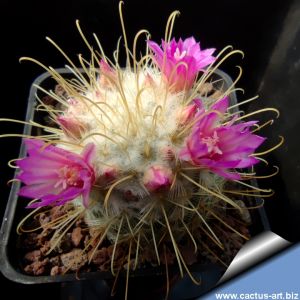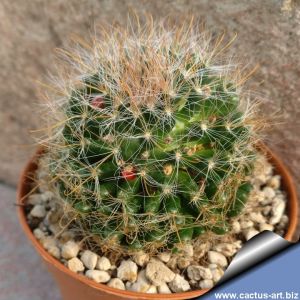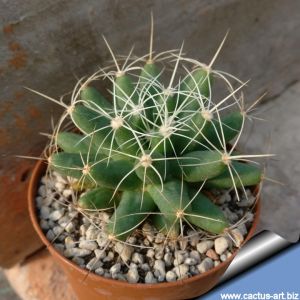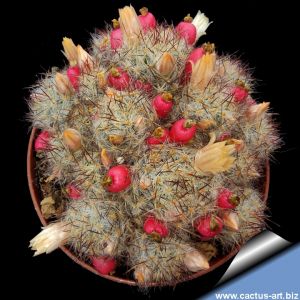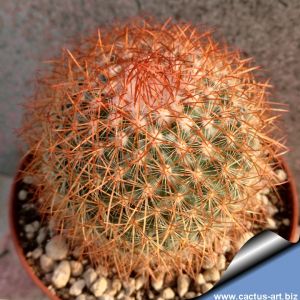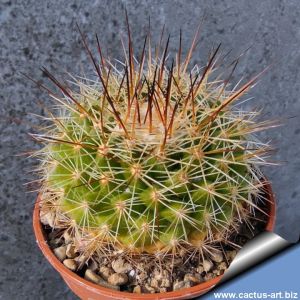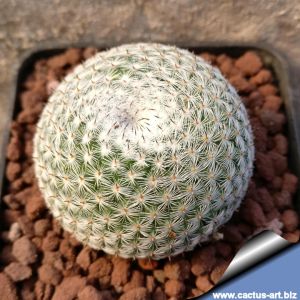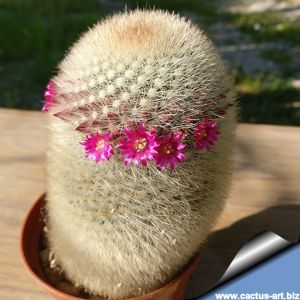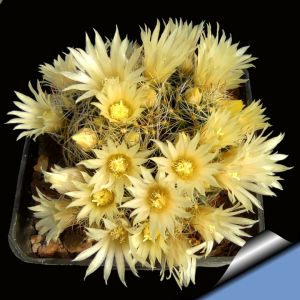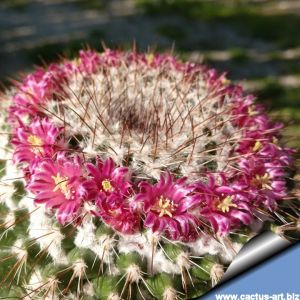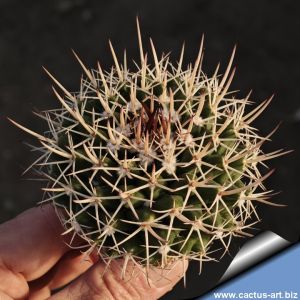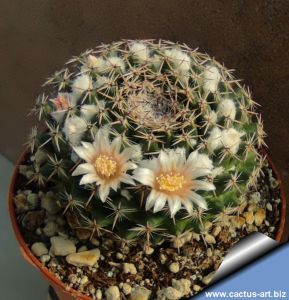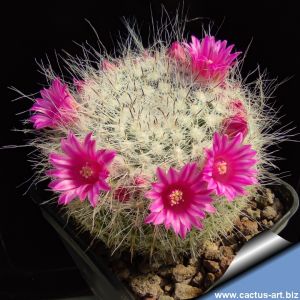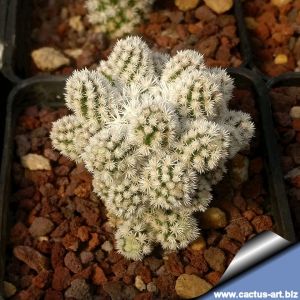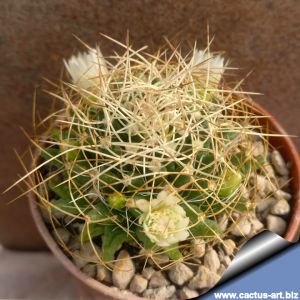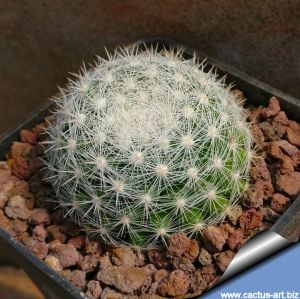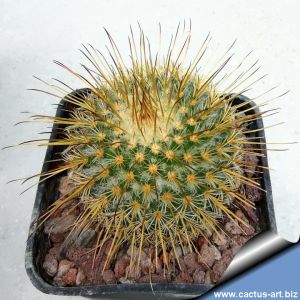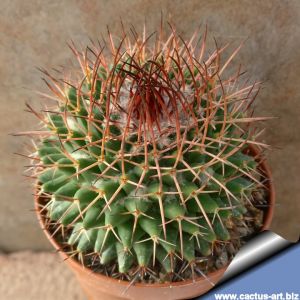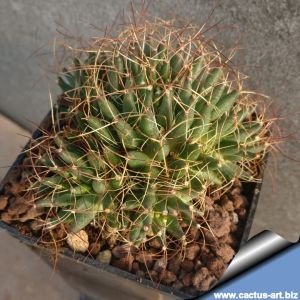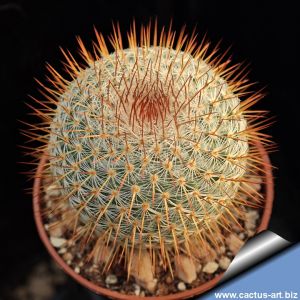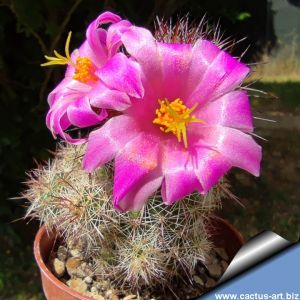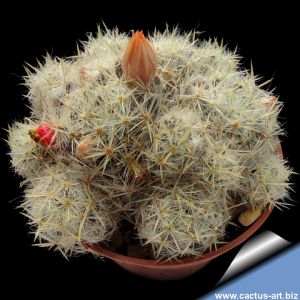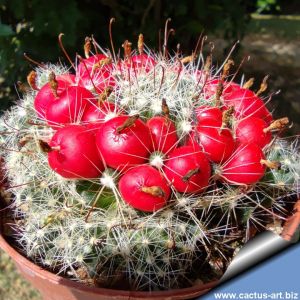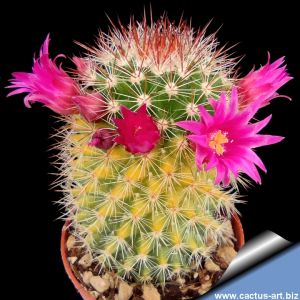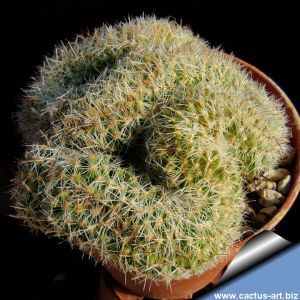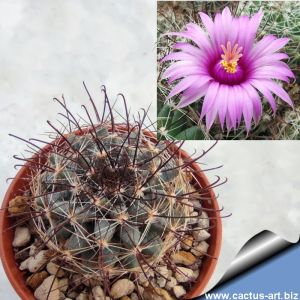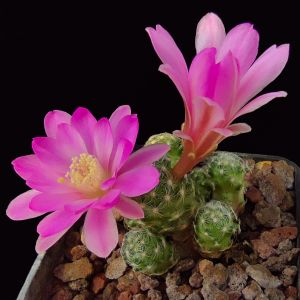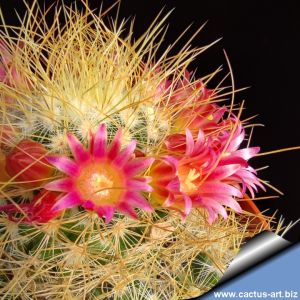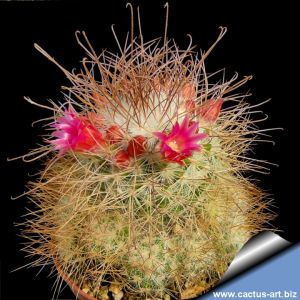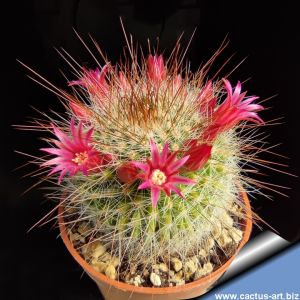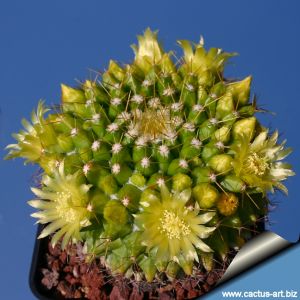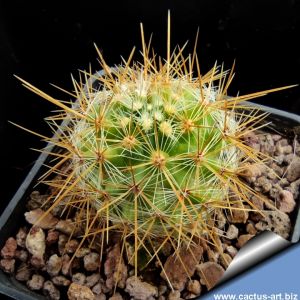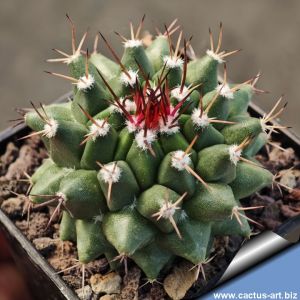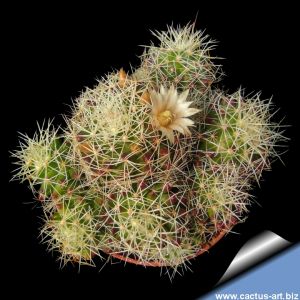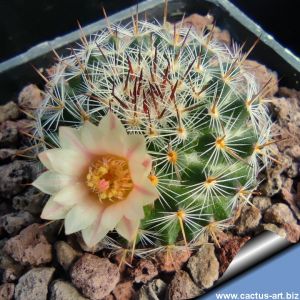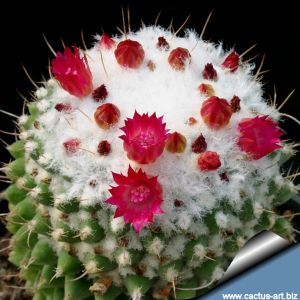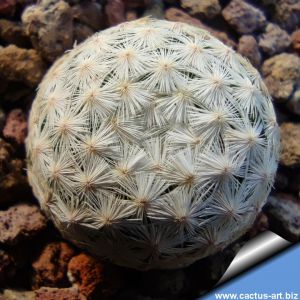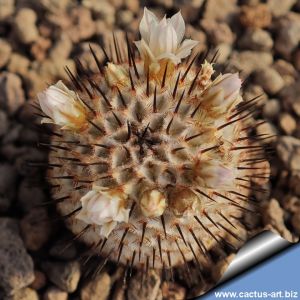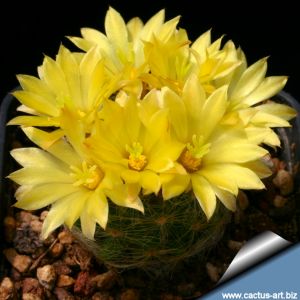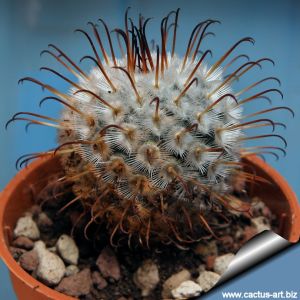-
1
Pale gray-green, finger-like cylindrical stems easily form lateral offsets into small clusters. Areoles feature 10–15 radial spines, often white or beige with darker tips, and 1–3 central spines. Blooms are a vibrant purple-red to carmine.
-
2
Mammillaria nejapensis cv. multiprolifera produces in a short time thousands of tiny, tightly pached stems all around its base.
-
3
Mammillaria multidigitata is endemic to San Pedro Nolasco Island in Mexico, where it growson steep slopes. From spring to early summer it sprouts white to cream colored flowers with yellow-green stigma and orange pollen.
-
4
Mammillaria sempervivi f. montruosa is distinguished by the single long central thorn in each areole. It clumps flat with ground. The white wool between the areoles makes this species a pleasure to look at and grow.
-
5
ammillaria collinsii features white flowers with pink mid-veins, a central spine, and 7 radial spines. Stems grow to 16 cm tall and 9 cm wide, branching from the base to form clumps up to 40 cm in diameter.
-
6
The Mammillaria hahniana f. elongata is distinguished by its stem, which over time develops a short columnar shape. The plant, covered in long white bristles, is strikingly beautiful.
-
7
-
8
-
9
Mammillaria variaculeata is a clumping cactus forking dichotomously. It has rather uninteresting short spines when young, before making a fierce and very showy mature dark brown spination. However the species comprises plants with variable spine length.
-
10
-
11
A rounded body with long, soft tubercles and slender cream-coloured spines. The real highlight is the enormous flowers, glowing in an intense yellow and creating a striking visual contrast.
-
12
Very nice form with 4 (-6) very short orangish radial spines. The younger spines are yellow and very attractive).
-
13
-
14
It thrives alongside Ferocactus echidne REP1139A and Mammillaria priessnitzii REP1134 in its natural environment.
-
15
-
16
-
17
-
18
-
19
-
20
-
21
Mammillaria nejapensis is very variable, especially for the length of the spines, that greatly depends on sun exposure and age of the plant. This species forms large colonies by dichotomous division.
-
22
-
23
A flattened globular cactus reaching 4 cm in height and 8 cm in diameter, bearing central spines ranging from yellow-amber to reddish-brown and vivid carmine-red blooms.
-
24
Mammillaria bombycina v. flavispina is a selected form that differs from the standard Mammillaria bombycina for its evenly creamy-yellow or yellow hooked central spines, (tips never dark reddish-brown).
-
25
-
26
-
27
Self-fertile plant. Produces flowers in succession over a long period. The red, edible berries are produced in abundance without the need for fertilization. Easy to grow.
-
28
Mammillaria tayloriorum (Mammillaria tayloriana) is endemic to the island of San Pedro Nolasco Island in the Gulf of California (Sonora, mexico) It grows together with Mammillaria multidigitata, Echinocereus websterianus and Pachycereus pringlei.
-
29
The variety ruberrima is a particularly distinctive form of the species Mammillaria rhodantha . The term "ruberrima" comes from Latin and means "very red" or "ruby-colored," which perfectly describes this variety's defining trait.
-
30
Mammillaria rhodantha is a shortly columnar cactus that characteristically divide dichotomously with age forming large clumps. The spines are the more variable of the trait. The dark form has vivid dark reddish-brown central spines.
-
31
-
32
Globose stems with a depressed apex, so densely covered in short spines and woolly axils that the surface is nearly invisible. Small flowers form a crown around the top, in shades from carmine to purplish-pink.
-
33
-
34
Stem, tuberous at the base, globose to ovoid in shape. Spines are fine, bristle-like and pubescent—yellowish below, white mid-length, brown or amber at the tips. A genuine winter bloomer, producing greenish-white flowers even when very young.
-
35
Symmetric round cactus with short, hard spines. Small purple flowers form a ring around the stem apex.
-
36
‘Horrida’ is a striking form distinguished by formidable, more robust spines than the typical species. Its low habit and rapid growth make it highly ornamental , and over time it develops into a majestic hemispheric cushion. Flowers are pink-purple.
-
37
-
38
Mammillaria woodsii, white stem with small tubercles, each adorned with white radial spines and brown-black centrals, set in thick wool. Flowers form a reddish-purple crown in spring and summer. Beautiful!
-
39
Dwarf form of ARIZONA SNOWCAP
-
40
Mammillaria camptotricha (Dolichothele camptotricha) - Flat clusters of small stems with elongated tubercles and slender, twisted spines that envelop the body (hence "Bird’s Nest Cactus").
-
41
Mammilloydia candida called 'Snowball' is a choice cactus with a so dense snowy white, spination, that its body appears hidden by spines. Mammilloydia are clearly related to the genus Mammillaria, but it is usually recognized as a segregate genera.
-
42
Very pretty plants with long pale amber to reddish central spines, pink flowers.
-
43
Mammillaria carnea is a rather robust cactus species. The plant typically has 4-sided angular tubercles with yellow, woolly axils and only 4 reddish radial spines. It will reward the skilled growers with ring of fine flesh-pink flowers circling the crown.
-
44
Mammillaria camptotricha (Dolichothele camptotricha) - Flat clusters of small stems with elongated tubercles and slender, twisted spines that envelop the body (hence "Bird’s Nest Cactus"). This variety has spines in dull cream to brown tones.
-
45
Charming variegated form with yellow-cream tubercle bases. The
variegation peaks under filtered light, while harsh sun encourages
reversion to green. A fascinating dance between color and light
exposure.
-
46
Mammillaria conspicua, can be distinguished from the other forms of the Mammillaria haageana complex because it is often solitary and has larger stems up to 10-11 cm in diameter. Each head is surrounded by a full ring of magenta pink star-like flowers.
-
47
Mammillaria occidentalis also known as Mammillaria mazatlanensis var. occidentalis is a clumping species which has large pink flowers in summer. The flowers are slightly scented. These can be followed by red fruits.
-
48
A miniature Mammillaria that rapidly develops tight clusters of many small, ivory-spined stems. It produces abundant yellow flowers and, without requiring pollination, sets edible red berries thanks to its self-fertile nature.
-
49
Mammillaria oteroi clusters freely and the offsets detach readily. It has some of the roundest fruits among mammillarias. The fruits are globose, 7-8 mm long, bright red. Flowers are pale yellowish green with muddy cerise midstripe.
-
50
Variegated plants have sectors, patches or stripes with two or more colours. Plants with variegated body are highly prized. Very variable.
-
51
-
52
Hooked central spines all twisted counterclockwise create a distinctive spiral pattern. The real showstopper? Exceptionally large flowers in deep pink-magenta that dazzle against the spiny armor. Truly one of nature's most remarkable creations!
-
53
-
54
Nature's tiny masterpiece: dwarf globes wrapped in comb-like silky spines. Neon-pink blooms dwarfing their host! Substantial taproot. Painstakingly slow growth, making each specimen precious.
-
55
Pretty with long twisted yellow spines, magnificent!
-
56
The long, thin, twisted spines give the plant a soft and highly ornamental appearance. This distinctive spine morphology sets it apart from other variants of the species, making it especially valued among collectors.
-
57
-
58
Mix of Mammillarias, featuring various species, hybrids, and seed-grown cultivars. Each plant is one-of-a-kind, with unique shapes, spination, and flower colors.
-
59
-
60
Pretty with long yellowish spines.
-
61
Mammillaria polyedra is a low growing cactus, solitary at first, later branching to form colonies or cushions. Flower pink or reddish.
-
62
-
63
Selected form with very long yellow spines, pink flowers, very beautiful species!
-
64
Areoles with dense white wool, axils with very dense white wool and numerous long white bristles. Spines heavy orange-yellow to reddish. Seldom seen in cultivation. Very nice.
-
65
-
66
Mammillaria chionocephala is an attractive globose pincushion cactus with white to rose-red flowers, in a circle near the summit.
-
67
Long twisted cream colored spines form an intricate nest-like pattern on top.
-
68
A distinctive and highly attractive cultivar with little to no spines. Elongated tubercles are topped with brilliant white wool, contrasting beautifully with vivid deep pink flowers. Looks like a fluffy, elegant plush toy.
-
69
A tiny cactus resembling a golf ball, densely covered in appressed white spines. Its flowers are remarkably large for a Mammillaria—vivid pink-purple and highly showy.
-
70
Mammillaria perezdelarosae ssp. andersoniana is a marvellous tiny cactus distinguishable from the standard species for its smaller size, slower growth and straight central spines (not hooked). It is believed to be one of the most beautiful Mammillaria.
-
71
Soft whitish spines, rather big yellow flowers, lemon scented! Grows toghether with Pilosocereus palmeri, Mammillaria candida, Echinocereus blanckii and Ritterocereus pruinosus.
-
72
Don’t miss this one! A petite cactus with snow-white radials and hooked mahogany-colored central spines. When in bloom, it dazzles with pink flowers. The ultimate treasure for rare plant collectors.

